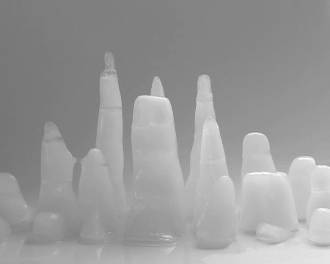The Oda series came out of a performance in Italy, in winter 2008. This work, which the artist had been considering for some time, revolved around the presence of a black horse, as black as possible. It took him a long time to find Odalisque, a mare, and when he did, it was by chance. Javier Perez doesn't consider himself as a photographer, and everything about the images in the series point to a sculptor, in the sense of someone who "lifts away': the close framing of the contact between the two skins, the black background that isolates the forms, the fragmentation of the bodies in a sequence of close shots in which the face remains always elusive; everything is stripped, from naked artist to the surrounding landscape. The acquisition of this work reflects the policy of enriching the collections with work that lies on the edge, where different disciplines come together, and in the meeting of sculpture and photography - in this case, echoing a performance.
Vasco Ascolini makes black the main constituent of his images. The photographer's images are governed by this black material, the incarnation of emptiness, whose depth has a wholly metaphysical dimension. Vasco Ascolini has practised judo to a high level for many years (one of his judo masters also trained the artist, Yves Klein). He is fascinated by the philosophy of judo, in which the notion of the vacuum is fundamental.
In this series, Vasco Ascolini sets out to transpose the principles and philosophy of judo into the image: he places the two adversaries against an impenetrable black which isolates them in an absolute vacuum. The negatives of this series have never been developed. Discovered recently by the photographer, among a collection of almost 60,000 negatives, they were printed for the first time in 2011. The photographer limited their production to 3 copies. The museum already possess a large collection of images by Vasco Ascolini, most of which are the result of a 1990 commission on the architectural heritage of Arles.

The work of Sterenn Donnio, who graduated from the École Nationale Supérieure de la Photographie, Arles in 2011, is deeply influenced by the concept of disappearance. His works all speak of the permanence - or rather the impermanence - of objects in the face of weather, neglect or destruction. To make this video, whose full title is Anastylose, ville éphémère, the artist first sculpted a cityscape out of ice. The filming of this imaginary town, which is at once improbable and strangely familiar, was made according to a protocol that strengthens the element of ambiguity. The 4 hours it took for the ice to melt naturally has been reduced to 14 minutes, leaving enough time for a hypnotic journey between disappearance and reconstruction. At the film's mid-point, the process is reversed, and the town takes shape again, in a new kind of anastylose. The Réattu museum, which cultivates strong links with the École Nationale Supérieure de la Photographie, a hotbed of talent, has already acquired two other powerful pieces by graduates just out of the school: I'm living, I'm dying by Sun Yung Ha in 1999, and Barroco by Mélina Jaouen in 2010, two videos which are very much linked to performance and in which the bodies of the artist form the central object. What is interesting about Anastylose is the way in which it deploys another approach, exploring the world of fiction through an ephemeral and entirely constructed installation.
Michel Duport is among the artists who have revisited the principles of the French classical school of painting, but in a very contemporary way. All his works give pride of place to drawing, no matter what category he is approaching, in two or three dimensions. Recently, his works on die-cast aluminium appear to be the latest avatar of his attachment to the area between sculpture and painting. The artist's donation of two of these casts, complete with their uniquely adapted plaster plinths, and 4 preparatory drawings, has greatly enhanced the presence of his work within the museum (which already possesses a painting, a relief and a small tableau-volume). The ensemble allows the public to fully appreciate a singular journey through the question of painting and the way in which it is presented.